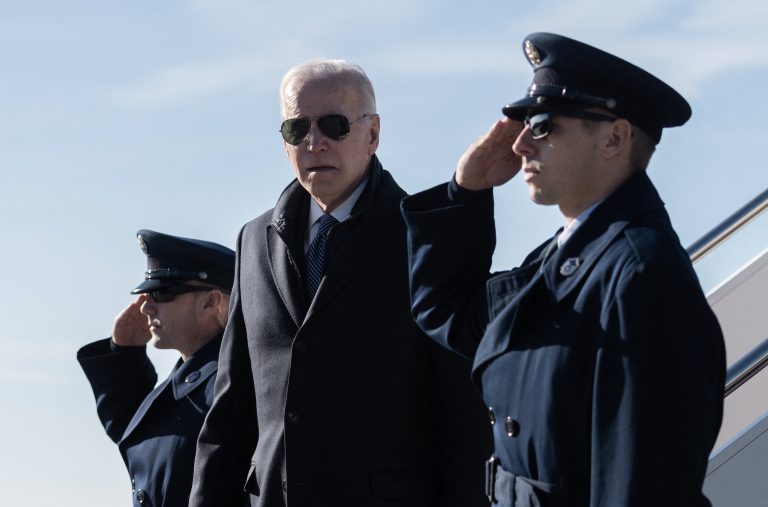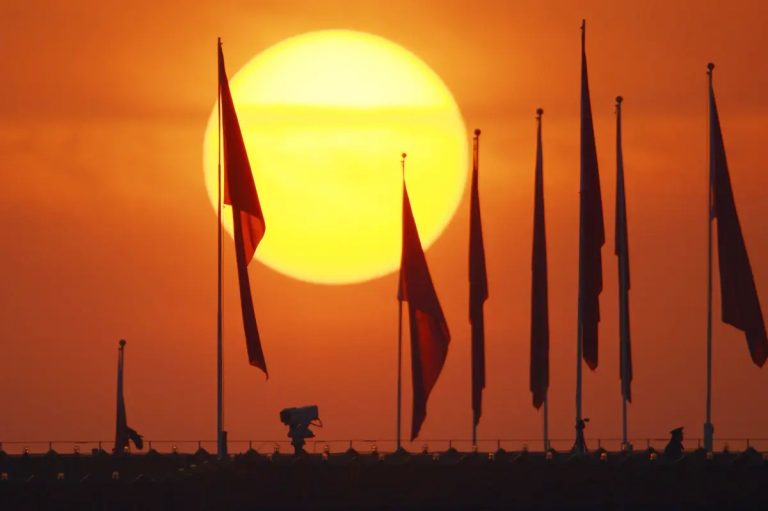News that a high-altitude reconnaissance balloon sent by Communist China has been loitering over the northern U.S. stoked fear and finger-pointing among officials and the media, with many jumping on the event to highlight the threat from Beijing or criticize the Biden administration of being soft on the Chinese regime.
The Chinese spy balloon, roughly three times the size of a school bus, was discovered by passengers aboard an airliner as it passed over Montana on Wednesday, Feb. 1.
U.S. Air Force jets shot down the balloon on Saturday (Feb. 4), following President Joe Biden’s statement that “we’re going to take care of it.” The intruder was destroyed over the East Coast, off the shores of South Carolina.
According to Biden, he had wanted to shoot the balloon down on Wednesday, but after a defense briefing opted not to bring down the balloon until it could be determined that falling debris would not pose a risk to people or property.
It was furthermore noted that intelligence collected by the balloon would be “limited additive value” given that China can already observe America’s geography and military installations using spy satellites.
Success
You are now signed up for our newsletter
Success
Check your email to complete sign up
This has been disputed by retired Air Force Col. Cedric Leighton, now a CNN military analyst, saying that the balloon’s closer proximity to the ground — around 60,000 feet — could allow it to better track American signals and relay them to Chinese satellites.
“The United States Government has detected and is tracking a high altitude surveillance balloon that is over the continental United States right now,” the Department of Defense said in a Feb. 2 statement.
“The U.S. government, to include NORAD, continues to track and monitor it closely,” the statement continued. “The balloon is currently traveling at an altitude well above commercial air traffic and does not present a military or physical threat to people on the ground. Instances of this kind of balloon activity have been observed previously over the past several years. Once the balloon was detected, the U.S. government acted immediately to protect against the collection of sensitive information.”
The People’s Republic of China (PRC) foreign ministry apologized for the intrusion and claimed that the balloon was a “weather observation airship” that have unfortunately been blow off-course, while the Pentagon rejected this explanation, saying that the vehicle was clearly outfitted with reconnaissance equipment.
Moreover, the balloon’s flight took it over Montana’s Malmstrom Air Force Base — the site of 150 Minuteman III nuclear missiles and their launch silos. The intercontinental ballistic missiles are an important component in the American nuclear deterrent, along with long-range bombers and ballistic missile-carrying submarines.
According to the Wall Street Journal, the Air Force scrambled two F-22 fighters to intercept the balloon. Later reports on Thursday showed three KC-135R Stratotankers belonging to the air force circling around the balloon.
On Friday, Feb. 3, Pentagon Press Secretary Brig. Gen. Pat Ryder confirmed that a second Chinese spy balloon was “transiting Latin America,” according to NBC News.
Falling out
On Friday, U.S. Secretary of State Antony Blinken postponed a scheduled trip to Beijing that night in protest over the Chinese balloon, saying it was an “irresponsible act and a clear violation of U.S. sovereignty and international law” on the PRC’s part.
While noting “the PRC statement of regret,” the Pentagon also protested the intrusion as “unacceptable.”
Various media outlets criticized the Chinese Communist Party’s act of espionage. Axios wrote on Friday that “if confirmed to be a Chinese surveillance balloon, it would be one of Beijing’s most aggressive intelligence-gathering attempts in recent years.”
The Wall Street Journal repeated the sentiment in its Thursday report on the incident, using the phrase “aggressive act” to describe the balloon’s course, before detailing the context of the event, including the recent history of large Chinese-made weather balloons.
According to a senior U.S. defense official who spoke anonymously with NBC News, Chinese balloons have floated over American airspace before, though usually for shorter periods. “This type of activity is not unprecedented,” NBC said.
Aerial reconnaissance has been commonplace since the advent of reliable aircraft, but has been largely superseded by spy satellites, which are unmanned and do not violate national airspace. During the Cold War, the U.S. routinely sent flights of the U-2 and SR-71 spy planes across the Soviet Union, China, and other countries. Balloons have also been used in intelligence gathering for over a century.
Despite the calm with which the Department of Defense and Biden administration approached the incident itself, it is curious that the event led to the postponement of Blinken’s high-level diplomatic trip to China, or that it gained the attention it did in the mainstream media.
Meanwhile, Republicans used the event to accuse Biden of yielding on national security and to highlight the threat from the CCP.
Kevin McCarthy, House Majority Speaker, criticized the administration on Twitter, writing in a Feb. 4 post that “First Biden refused to defend our borders. Now he won’t defend our skies.”
On Feb. 3, Rep. Elise Stefanik (R-N.Y.), who serves as the GOP conference chairwoman, slammed the administration’s reaction to the balloon.
“The Chinese Communist Party’s violation of the United States’ airspace and growing military aggression is a threat to our national security,” Stefanik said. “This should be a wakeup call for Joe Biden’s weakness on the world stage.”
She said: “[Biden] can no longer allow China, our greatest geopolitical challenge, to undermine us … I am demanding an immediate intelligence briefing, so that we can know exactly how this happened and what malign intentions are behind this spying to ensure we hold China accountable, so the CCP does not violate American sovereignty again.”
Rep. Jim Jordan (R-Ohio), who chairs the important House Judiciary Committee, said that “Communist China … flies a spy balloon over our country. And what’s Joe Biden doing about it? Nothing.”
Fox News’ Tucker Carlson, America’s most popular conservative media personality, expressed concern at the fact that the Pentagon had been tracking the Chinese balloon for months before it reached North America.
“That means they watched it float over the Pacific. They watched it pass over the Aleutian Islands and into American airspace and at any time, they could have shot it down over the water,” he noted, wondering, “Why didn’t they do that? No one will say.”
Former Secretary of State Mike Pompeo called upon the Biden administration to “shoot down the CCP’s balloon safely, and demand answers from Xi.”
Some made far-reaching comments about the consequences of the incident. In a Feb. 3 op-ed published on the Wall Street Journal, neoconservative scholar Robert Kagan — senior fellow with the Brookings Institution — linked the Chinese spy balloon with the potential of Chinese leader Xi Jinping to bring his regime into direct confrontation with the U.S. or its allies.
Kagan posited that “at this moment of high tension over Taiwan and the Chinese spy balloon detected this week over the U.S., [Chinese leader] Xi Jinping runs the risk of making the same historic mistake” as World War II-era Japan, which launched a surprise attack against the U.S. naval base at Pearl Harbor in December 1941.
















